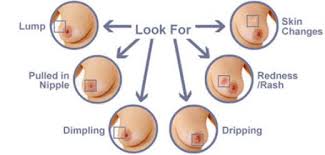
Breast cancer starts when the cells in the breast begin to grow out of control. These cells usually form a tumor can often be seen on an x-ray or breast ultrasound or CT scan.
Breast cancer
Breast cancer can occur in both men and women, but it's far more common in women. It is one of the types of cancer that forms in the cells of the breasts.
Breast cancer stages range from 0 to IV with 0 indicating cancer that contained within the milk ducts or it is noninvasive. Stage IV breast cancer, also called metastatic breast cancer, and indicates that the cancer spread to whole body organs.
Signs and symptoms:
· Change in the shape, size, or appearance of a breast
· A breast lump or thickening from the surrounding tissue
· A newly inverted nipple
· Pitting or redness of the skin over breast
Causes:
Risk factors:
· Increasing age
· Being female
· A personal history of breast cancer
· Inherited genes that increase cancer risk
· A family history of breast cancer
· Radiation exposure
· Obesity
· Beginning menopause at an old age
· Consumption of alcohol
Diagnosis:
· Breast exam: For checking of lymph nodes and breasts in the armpit, observing for any other abnormalities or lumps.
· Mammogram: A mammogram is an X-ray of the breast.
· Breast ultrasound:
· Biopsy (Removing a sample of breast cells for testing): Used to determine whether the cells are cancerous or not.
· Breast MRI (magnetic resonance imaging): An MRI machine uses a magnet and radio waves to create pictures of the interior of breast.
· Blood tests, such as a complete blood count
· Bone scan
· Computerized tomography (CT) scan
· Positron emission tomography (PET) scan
Treatment:
Breast cancer surgery
Operations used to treat breast cancer include:
· Lumpectomy (Removing the breast cancer): This may be referred to as breast-sparing surgery or wide local excision, during lumpectomy, the surgeon removes the small margin of surrounding healthy tissue along with tumor. Lumpectomy is typically reserved for smaller tumors.
· Mastectomy (Removing the entire breast): It is an operation to remove all of the breast tissue such as fatty tissue, lobules, ducts, and some skin, including the nipple and areola (simple mastectomy). In a skin-sparing mastectomy, the skin over the breast intact to left to improve the appearance and reconstruction. Depending on the location and size of the tumor, the nipple also may be spared.
· Sentinel node biopsy (Removing a limited number of lymph nodes): To determine whether cancer has spread to lymph nodes, the surgeon will discuss with the role of removing the lymph nodes that are the first to receive the lymph drainage from tumor.
· Axillary lymph node dissection (Removing several lymph nodes): If cancer is found in the sentinel lymph nodes, surgeon will discuss with the patient about the role of removing additional lymph nodes in armpit.
· Contra lateral prophylactic mastectomy (Removing both breasts): Some women with cancer in one breast will have to choose other healthy breast to remove if they have a very increased risk of cancer in the other breast because of a strong family history or predisposition of genetic. Most women with breast cancer in one breast will never develop cancer in the other breast.
Complications of breast cancer surgery: Bleeding, pain, infection and arm swelling (lymph edema).
A side effect of this type of therapy includes a red, sunburn-like rash and fatigue where the radiation is aimed. Breast tissue appears more firm or swollen.
Chemotherapy: Chemotherapy uses drugs to destroy cancer cells. Chemotherapy is also used in women whose cancer has already spread to other parts of the body. Chemotherapy is recommended to control the cancer and decrease any symptoms the cancer is causing.
Common side effects chemotherapy includes nausea, hair loss, damage to the heart and kidneys, nerve damage, vomiting, fatigue, an increased risk of developing infection and premature menopause.
Selective estrogen receptor modulator (SERM) medications act by blocking from attaching of estrogen to the estrogen receptor on the cancer cells, slowing the growth of tumors and killing tumor cells. SERMs include raloxifene, tamoxifen, and toremifene.
Side effects include night sweats, blood clots, hot flashes, stroke, uterine cancer, vaginal dryness and cataracts.
Adverse effects include night sweats, joint and muscle pain, hot flashes, vaginal dryness, osteoporosis.
Targeted drugs: Targeted drug treatments attack specific abnormalities within the cancer cells. Targeted drugs used to treat breast cancer include:
· Trastuzumab
· Ado-trastuzumab
· Pertuzumab
· Lapatinib
· Palbociclib
· Everolimus
Breast cancer, lumps, milk ducts, lobules, dimpling of skin
references: